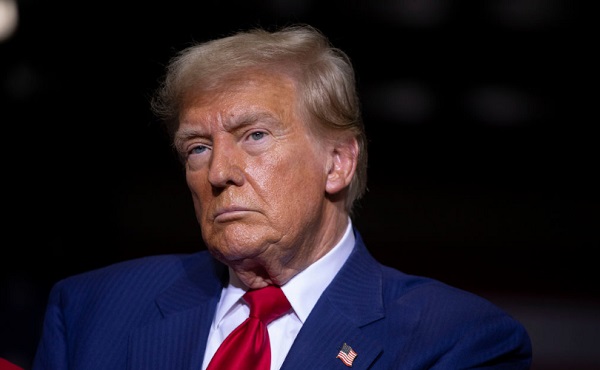Brownstone Institute
Trump’s 19th-Century Solution to Fiscal Disaster

From the Brownstone Institute
By
In the last weeks of the campaign, Donald Trump is slicing and dicing the Federal income tax nearly as fast as he served up fries at the McDonald’s drive-thru window last weekend. So far, he has proposed to extend the lower rates, family tax credits, and investment incentives of the 2017 Tax Act after they expire in 2025 and to also exempt tips, Social Security benefits, and overtime wages from the Federal income tax.
Those items alone would generate a revenue loss of $9 trillion over the next decade, but he has recently proposed to also exempt firefighters, police officers, military personnel, and veterans from the Federal income tax as well.
We estimate the latter would cost another $2.5 trillion in revenue loss over 10 years. As it happens, there are 370,000 firemen, 708,000 policemen, 2.86 million uniformed military personnel, and 18.0 million veterans in the US. These 22 million citizens have an estimated average income of $82,000 per year, which translates to about $60,000 each of AGI (adjusted gross income). At an average income tax rate of 14.7% these exclusions would generate $250 billion per year of reduced income tax payments.
In all, Trump has thus tossed out promises to cut income taxes by $11.5 trillion over the next 10-year budget window. In turn, these sweeping reductions would amount to upwards of 34% of CBO’s estimated baseline income tax revenue of $33.7 trillion over the period. Alas, even in the halcyon days of Reagan supply-side tax cutting no one really dreamed of eliminating fully one-third of the so-called crime of 1913 (the 16th Amendment which enabled the income tax).
10-Year Revenue Loss:
- Extend the 2017 Trump tax cuts: $5.350 trillion.
- Exempt overtime income: $2.000 trillion.
- End Taxation of Social Security benefits: $1.300 trillion.
- Exempt Tip income: $300 billion.
- Exempt Income of Firemen, Policemen, Military and Veterans: $2.500 trillion.
- Trump Total Revenue Loss: $11.500 trillion.
- CBO Income Tax Baseline Revenue: $33.700 trillion.
- Trump Revenue Loss As % of Baseline: 34%.
Then again, Trump may have something virtually epic in mind. To wit, scrapping the income tax entirely in favor of taxing consumption via levies on imported goods and merchandise.
“In the old days when we were smart, when we were a smart country, in the 1890s and all, this is when the country was relatively the richest it ever was. It had all tariffs. It didn’t have an income tax,” Trump said at a sit-down with voters in New York on Friday for Fox & Friends.
“Now we have income taxes, and we have people that are dying.”
The New York Times is deeply alarmed: “The former president has repeatedly praised a period in American history when there was no income tax, and the country relied on tariffs to fund the government.”
Actually, however, 19th-century America was even smarter than Trump realizes. In 1900 total Federal spending amounted to just 3.5% of GDP because back then America was still a peaceful republic and had no Warfare State or even significant standing army at all. And save for the most advanced precincts of Europe, the Welfare State hadn’t yet been invented, either.
So, yes, the so-called “revenue tariffs” of the 19th century did meet the income needs of the Federal government to the point of actually balancing the budget year after year between 1870 and 1900. Indeed, the actual annual surpluses were large enough to pay down most of the Civil War debt, to boot.
Today, of course, the Warfare State, Welfare State, and the Washington pork barrels account for 25% of GDP. So Trump may be directionally correct in wanting to tax consumption rather than income, but, as usual, he’s off by about seven orders of magnitude when it comes to the size of the Federal budget that needs to be financed.
Still, Trump has stepped up to the plate when it comes to a 21st-century version of the revenue tariff. He has pledged to impose a 20% universal tariff on all imports from all countries with a specific 60% rate for Chinese imports. Based on current US import levels of $3.5 trillion per year from worldwide sources and $450 billion from China, Trump’s tariffs would generate about $900 billion of receipts per annum.
To be sure, Trump’s claim that these giant tariffs would be paid for by Chinamen, Mexicans, and European socialists is just more of his standard baloney. Tariffs are paid for by consumers, but that’s actually the hidden virtue of the Tariff Man’s favorite word.
The truth is, government should be paid for via taxation on current citizens, not fobbed off in the form of giant debts on future citizens, born and unborn. So if we are going to have Big Government at 25% of GDP rather than a 19th-century government at 3.5% of GDP, and Trump is a Big Government Man if there ever was one, better that the burden be placed on consumption, not production, income, and investment.
After all, today the “makers” get hit good and hard by the current exceedingly lopsided income tax system. Thus, the top 1% pays 46% of income taxes, while the top 5% pays 66% and the top 10% pays 76% of all income taxes. On the other end, by contrast, the bottom 50% pays just 2.3% of individual income taxes, while 40% of all families pay no income tax at all.
In any event, the math works out such that the proposed Trumpian revenue tariffs would generate about $9 trillion over the next decade, or nearly 80% of the $11.5 trillion revenue loss from drastically shrinking the income tax coverage and collection rate. So that’s a big step in the direction of fiscal solvency rather than more UniParty free lunches.
To be sure, the proper redirection of Federal tax policy would be a national sales tax or VAT levy, which could be applied to both goods and services and to domestically produced output as well as to imports. Thus, a 5% VAT on the current $20 trillion per year of total PCE (personal consumption expenditures) would generate the equivalent of Trump’s revenue tariff, while a 15% levy on total PCE could replace both the Trump tariff and the remainder of the income tax entirely.
Notwithstanding its shortcomings, however, a revenue tariff is a long overdue start in the right direction. Trump’s bold stance in favor of taxing consumption rather than income and requiring all households to bear the cost of government, not just the small number of producers at the top of the economic ladder, is clearly superior to the status quo.
Still, this sweeping change in the composition and incidence of tax policy doesn’t really put the impending fiscal disaster to bed. Not by a long shot.
If you assume Trump’s big revenue tariffs and sweeping income tax cuts and that the other Federal payroll, corporate, and excise taxes remain the same, 10-year revenues compute to just $60 trillion versus built-in spending of $85 trillion per the CBO baseline. In short, even with a giant Trumpified version of the historical revenue tariff, Trump’s budget plan would still generate $25 trillion of red ink over the next decade.
10-Year Budget Outlook with Trump Tax Cuts and Tariffs, 2025 to 2034:
- Individual income taxes with Trump cuts: $22.0 trillion.
- Trump Revenue Tariffs: $9.0 trillion.
- Existing Payroll Taxes: $20.9 trillion.
- Existing Corporate Tax Ex-Trump Cut to 15% on Manufacturers: $4.6 trillion.
- Other Existing Federal Receipts: $3.5 trillion.
- Total Federal Revenue Under Trump Policy: $60.0 trillion.
- CBO Baseline Federal Outlays: $85.0 trillion.
- 10-Year Trump Deficit: $25.0 trillion.
To be sure, Trump has promised to turn Elon Musk loose on a crusade against government waste and inefficiency, and we say more power to him. If anyone has the courage and smarts to take on the Swamp, surely Elon Musk is at the top of the list.
Then again, Trump has promised to shield 82% of the budget from any cuts at all. That’s right. Elon could huff and puff and shrink the non-exempt programs and agencies by one-third and still leave deficits in excess of $20 trillion over the next decade.
10-year Cost Of Programs Trump Has Championed, Promised Not To Cut or Can’t Cut:
- Social Security: $20.0 trillion.
- Medicare: $16.0 trillion.
- Federal Military and Civilian Retirement Pensions: $2.5 trillion.
- Veterans’ programs: $3.0 trillion.
- National Security Budget: $15.5 trillion.
- Interest On the Public Debt: $13.0 trillion.
- Total Exempt Programs: $70.0 trillion.
- Exempt Programs As % of $85 trillion CBO Baseline: 82%.
In short, even with Trump’s full revenue tariffs and assuming Elon could actually slash 33% of the non-exempt budget without closing the Washington Monument, the bottom-line math leaves little to the imagination. Spending at $80 trillion would amount to 22.7% of GDP, while Trump’s tariff-heavy revenue package would generate $60 trillion of Federal receipts over the next decade, amounting to about 17.0% of GDP.
In turn, that would leave a structural deficit of nearly 6% of GDP as far as the eye can see. And that projection assumes no recession ever again and that interest on a public debt approaching $60 trillion by 2034 would average just 3.3% across the maturity spectrum.
We will take the unders on that proposition any day of the week and twice on Sunday. That is to say, CBO’s projection of $1.7 trillion of annual interest expense by 2034 is likely understated by several trillion. Per year.
In any event, the challenge of financing these giant deficits along with $900 billion per year of Trump tariffs would be considerable. The latter alone would amount to nearly 10% of annual US consumption of consumer goods and fixed investment goods.
So if the Fed were to “accommodate” these massive Trump tariffs by running the printing presses red-hot in an attempt to compensate for lost household purchasing power, it could well trigger a burst of inflation even more virulent than that of 2021-2024.
On the other hand, were it to adhere to the correct sound money solution and refuse to “accommodate” both the massive Trump deficits and the giant Trump tariffs, bond yields, and interest rates would soar, even as the Main Street economy contracted sharply in response to a one-time 10% increase in the general price level.
Financing massive budget deficits honestly in the bond pits rather than at the Fed’s printing presses would also unleash the mother of all meltdowns in today’s insanely inflated financial markets. Trump would therefore get his tariff and some substantial reshoring of industrial production, but also a hair-curling recession on Main Street and a Bronx Cheer from the canyons of Wall Street.
Unfortunately, that’s the price America would have to pay even under Trumpian economics to purge the destructive effects of decades of UniParty spend, borrow, and print policies.
Still, we can actually think of a decidedly worse scenario. To wit, perpetuation of the UniParty status quo, which is what we would get from the Washington ruling party that replaced a failing mind in the Oval Office with an empty one on the Democratic presidential ticket.
A version of this piece appeared on the author’s site.
Brownstone Institute
Bizarre Decisions about Nicotine Pouches Lead to the Wrong Products on Shelves

From the Brownstone Institute
A walk through a dozen convenience stores in Montgomery County, Pennsylvania, says a lot about how US nicotine policy actually works. Only about one in eight nicotine-pouch products for sale is legal. The rest are unauthorized—but they’re not all the same. Some are brightly branded, with uncertain ingredients, not approved by any Western regulator, and clearly aimed at impulse buyers. Others—like Sweden’s NOAT—are the opposite: muted, well-made, adult-oriented, and already approved for sale in Europe.
Yet in the United States, NOAT has been told to stop selling. In September 2025, the Food and Drug Administration (FDA) issued the company a warning letter for offering nicotine pouches without marketing authorization. That might make sense if the products were dangerous, but they appear to be among the safest on the market: mild flavors, low nicotine levels, and recyclable paper packaging. In Europe, regulators consider them acceptable. In America, they’re banned. The decision looks, at best, strange—and possibly arbitrary.
What the Market Shows
My October 2025 audit was straightforward. I visited twelve stores and recorded every distinct pouch product visible for sale at the counter. If the item matched one of the twenty ZYN products that the FDA authorized in January, it was counted as legal. Everything else was counted as illegal.
Two of the stores told me they had recently received FDA letters and had already removed most illegal stock. The other ten stores were still dominated by unauthorized products—more than 93 percent of what was on display. Across all twelve locations, about 12 percent of products were legal ZYN, and about 88 percent were not.
The illegal share wasn’t uniform. Many of the unauthorized products were clearly high-nicotine imports with flashy names like Loop, Velo, and Zimo. These products may be fine, but some are probably high in contaminants, and a few often with very high nicotine levels. Others were subdued, plainly meant for adult users. NOAT was a good example of that second group: simple packaging, oat-based filler, restrained flavoring, and branding that makes no effort to look “cool.” It’s the kind of product any regulator serious about harm reduction would welcome.
Enforcement Works
To the FDA’s credit, enforcement does make a difference. The two stores that received official letters quickly pulled their illegal stock. That mirrors the agency’s broader efforts this year: new import alerts to detain unauthorized tobacco products at the border (see also Import Alert 98-06), and hundreds of warning letters to retailers, importers, and distributors.
But effective enforcement can’t solve a supply problem. The list of legal nicotine-pouch products is still extremely short—only a narrow range of ZYN items. Adults who want more variety, or stores that want to meet that demand, inevitably turn to gray-market suppliers. The more limited the legal catalog, the more the illegal market thrives.
Why the NOAT Decision Appears Bizarre
The FDA’s own actions make the situation hard to explain. In January 2025, it authorized twenty ZYN products after finding that they contained far fewer harmful chemicals than cigarettes and could help adult smokers switch. That was progress. But nine months later, the FDA has approved nothing else—while sending a warning letter to NOAT, arguably the least youth-oriented pouch line in the world.
The outcome is bad for legal sellers and public health. ZYN is legal; a handful of clearly risky, high-nicotine imports continue to circulate; and a mild, adult-market brand that meets European safety and labeling rules is banned. Officially, NOAT’s problem is procedural—it lacks a marketing order. But in practical terms, the FDA is punishing the very design choices it claims to value: simplicity, low appeal to minors, and clean ingredients.
This approach also ignores the differences in actual risk. Studies consistently show that nicotine pouches have far fewer toxins than cigarettes and far less variability than many vapes. The biggest pouch concerns are uneven nicotine levels and occasional traces of tobacco-specific nitrosamines, depending on manufacturing quality. The serious contamination issues—heavy metals and inconsistent dosage—belong mostly to disposable vapes, particularly the flood of unregulated imports from China. Treating all “unauthorized” products as equally bad blurs those distinctions and undermines proportional enforcement.
A Better Balance: Enforce Upstream, Widen the Legal Path
My small Montgomery County survey suggests a simple formula for improvement.
First, keep enforcement targeted and focused on suppliers, not just clerks. Warning letters clearly change behavior at the store level, but the biggest impact will come from auditing distributors and importers, and stopping bad shipments before they reach retail shelves.
Second, make compliance easy. A single-page list of authorized nicotine-pouch products—currently the twenty approved ZYN items—should be posted in every store and attached to distributor invoices. Point-of-sale systems can block barcodes for anything not on the list, and retailers could affirm, once a year, that they stock only approved items.
Third, widen the legal lane. The FDA launched a pilot program in September 2025 to speed review of new pouch applications. That program should spell out exactly what evidence is needed—chemical data, toxicology, nicotine release rates, and behavioral studies—and make timely decisions. If products like NOAT meet those standards, they should be authorized quickly. Legal competition among adult-oriented brands will crowd out the sketchy imports far faster than enforcement alone.
The Bottom Line
Enforcement matters, and the data show it works—where it happens. But the legal market is too narrow to protect consumers or encourage innovation. The current regime leaves a few ZYN products as lonely legal islands in a sea of gray-market pouches that range from sensible to reckless.
The FDA’s treatment of NOAT stands out as a case study in inconsistency: a quiet, adult-focused brand approved in Europe yet effectively banned in the US, while flashier and riskier options continue to slip through. That’s not a public-health victory; it’s a missed opportunity.
If the goal is to help adult smokers move to lower-risk products while keeping youth use low, the path forward is clear: enforce smartly, make compliance easy, and give good products a fair shot. Right now, we’re doing the first part well—but failing at the second and third. It’s time to fix that.
Addictions
The War on Commonsense Nicotine Regulation

From the Brownstone Institute
Cigarettes kill nearly half a million Americans each year. Everyone knows it, including the Food and Drug Administration. Yet while the most lethal nicotine product remains on sale in every gas station, the FDA continues to block or delay far safer alternatives.
Nicotine pouches—small, smokeless packets tucked under the lip—deliver nicotine without burning tobacco. They eliminate the tar, carbon monoxide, and carcinogens that make cigarettes so deadly. The logic of harm reduction couldn’t be clearer: if smokers can get nicotine without smoke, millions of lives could be saved.
Sweden has already proven the point. Through widespread use of snus and nicotine pouches, the country has cut daily smoking to about 5 percent, the lowest rate in Europe. Lung-cancer deaths are less than half the continental average. This “Swedish Experience” shows that when adults are given safer options, they switch voluntarily—no prohibition required.
In the United States, however, the FDA’s tobacco division has turned this logic on its head. Since Congress gave it sweeping authority in 2009, the agency has demanded that every new product undergo a Premarket Tobacco Product Application, or PMTA, proving it is “appropriate for the protection of public health.” That sounds reasonable until you see how the process works.
Manufacturers must spend millions on speculative modeling about how their products might affect every segment of society—smokers, nonsmokers, youth, and future generations—before they can even reach the market. Unsurprisingly, almost all PMTAs have been denied or shelved. Reduced-risk products sit in limbo while Marlboros and Newports remain untouched.
Only this January did the agency relent slightly, authorizing 20 ZYN nicotine-pouch products made by Swedish Match, now owned by Philip Morris. The FDA admitted the obvious: “The data show that these specific products are appropriate for the protection of public health.” The toxic-chemical levels were far lower than in cigarettes, and adult smokers were more likely to switch than teens were to start.
The decision should have been a turning point. Instead, it exposed the double standard. Other pouch makers—especially smaller firms from Sweden and the US, such as NOAT—remain locked out of the legal market even when their products meet the same technical standards.
The FDA’s inaction has created a black market dominated by unregulated imports, many from China. According to my own research, roughly 85 percent of pouches now sold in convenience stores are technically illegal.
The agency claims that this heavy-handed approach protects kids. But youth pouch use in the US remains very low—about 1.5 percent of high-school students according to the latest National Youth Tobacco Survey—while nearly 30 million American adults still smoke. Denying safer products to millions of addicted adults because a tiny fraction of teens might experiment is the opposite of public-health logic.
There’s a better path. The FDA should base its decisions on science, not fear. If a product dramatically reduces exposure to harmful chemicals, meets strict packaging and marketing standards, and enforces Tobacco 21 age verification, it should be allowed on the market. Population-level effects can be monitored afterward through real-world data on switching and youth use. That’s how drug and vaccine regulation already works.
Sweden’s evidence shows the results of a pragmatic approach: a near-smoke-free society achieved through consumer choice, not coercion. The FDA’s own approval of ZYN proves that such products can meet its legal standard for protecting public health. The next step is consistency—apply the same rules to everyone.
Combustion, not nicotine, is the killer. Until the FDA acts on that simple truth, it will keep protecting the cigarette industry it was supposed to regulate.
-

 armed forces1 day ago
armed forces1 day agoIt’s time for Canada to remember, the heroes of Kapyong
-

 Digital ID1 day ago
Digital ID1 day agoCanada moves forward with digital identification for federal benefits seekers
-

 Daily Caller1 day ago
Daily Caller1 day agoUS Nuclear Bomber Fleet Shares Fence With Trailer Park Linked To Chinese Intel-Tied Fraudster
-

 Alberta1 day ago
Alberta1 day agoSchool defunding petition in Alberta is a warning to parents
-

 Daily Caller1 day ago
Daily Caller1 day agoLaura Ingraham Presses Trump On Allowing Flood Of Chinese Students Into US
-

 Opinion2 days ago
Opinion2 days agoThe Germans called her the ‘White Mouse’ for her elusiveness
-

 espionage1 day ago
espionage1 day agoChinese-Owned Trailer Park Beside U.S. Stealth Bomber Base Linked to Alleged Vancouver Repression Case
-

 Business2 days ago
Business2 days agoLiberals refuse to disclose the amount of taxpayer dollars headed to LGBT projects in foreign countries











